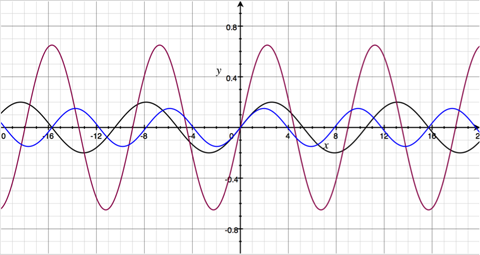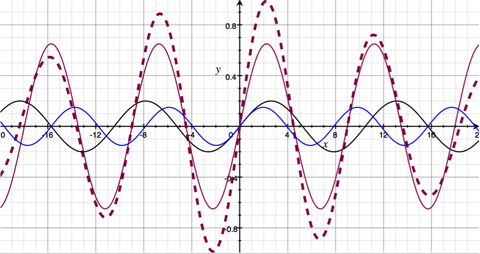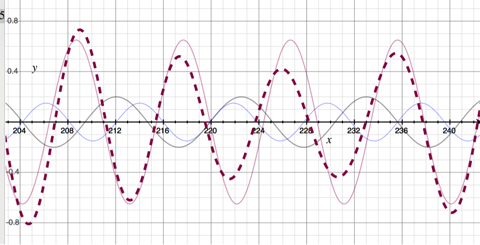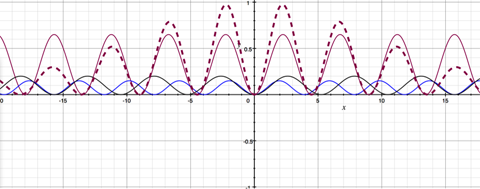Nobel Neutrinos
December 31, 2015
The 2015 Nobel Prize in Physics was awarded to Arthur McDonald and Takaaki Kajiti, for “the discovery of neutrino oscillations, which shows that neutrinos have mass,” according to the Nobel website1. But what is a neutrino, how does it oscillate, and why do these oscillations prove that it has mass?
The Prediction of the Neutrino
Around the 1900s, the field of physics was changing rapidly. In 1896 Becquerel discovered radioactivity, and a year later J.J. Thomson discovered the electron. In 1900, Planck introduced quantum theory. By 1905, Einstein had proposed the photoelectric effect and special relativity. Rutherford suggested a nuclear atom (with most of its mass concentrated in a tiny volume at the center) in 1911 based on evidence from foil-scattering experiments, and in 1919 he recorded the first nuclear reaction. In 1924, Louis de Broglie postulated that matter has wavelike aspects, an idea which was experimentally verified in 1927 by the work of Davisson and Germer. It was not until 1932 that the neutron, first theorized in 1920, was finally discovered, putting into place one of the final pieces of our modern picture of the atom. These 35 years comprised the birth of modern physics and set the stage for the neutrino, our little neutral particle.
Despite these rapid advances in our understanding of the quantum world, there was still a problem with the mechanics of a particular type of radioactive decay that was being studied, beta-minus decay—in which a neutron within the nucleus turns into a proton by ejecting a negatively-charged electron. (In beta-plus decay, a proton turns into a neutron, ejecting a positron, the electron’s antimatter counterpart.) Beta decay seemed to violate two cornerstone ideas in physics: conservation of energy (no creation or destruction of energy, just transferring it from one object to another or transforming it), and conservation of angular momentum (the total angular momentum of a system should be the same before and after the nuclear event).
The ejected electrons observed during these early experiments all had less kinetic energy than scientists expected, and showed a range of energies anywhere from just a little less than expected to zero (the total energy of the reaction should have been equal to the energy contained in the neutron—its binding energy). In 1931, Wolfang Pauli suggested that this discrepancy could be resolved if some other, as-yet undetected particle were being ejected along with the electrons, to carry away the missing energy. This particle would have to be electrically neutral to uphold charge conservation, have an angular momentum associated with it (so angular momentum could be conserved), and have an incredibly tiny mass. This hypothetical particle was eventually dubbed the neutrino, meaning “little neutral one”, as a play on neutrone, the Italian word for a neutron—“-ino” being a diminutive suffix.
Verification of the Neutrino's Existence
It took until 1956 to experimentally verify the existence of these neutrinos. Clyde Cowens and Fredrick Reines won the Nobel Prize in 1995 for this feat, incredible because neutrinos pass easily through matter and cannot be detected directly. Instead, the experimenters detected reactions caused by neutrinos. The ingenious experiment involved a huge tank of water near a nuclear reactor. The reactor was estimated to produce between 1 to 10 trillion neutrinos per second per square centimeter, of which an average of three neutrinos per hour were responsible for triggering detected reactions in the tank. The researchers made sure these neutrinos were coming from the reactor by comparing the detection rate with the reactor off. But still, this detection could not be used to determine the mass of a neutrino (which many scientists thought was zero), or its speed, which many assumed to be identical to the speed of light.
Solar Neutrinos
In 1968 Raymond Davis Jr. indirectly detected neutrinos produced by the Sun in an amazingly large-scale experiment involving a 10,000-gallon tank of tetrachloroethylene (a cleaning fluid primarily composed of chlorine). Scientists knew that certain nuclear reactions occur in the Sun, many of which produce neutrinos. They focused on a particular nuclear process in which a boron-8 atom decays to a beryllium-9 atom, emitting a positron and a neutrino that carries enough energy to interact with a chlorine-37 atom (hence the chlorine in the tank). It was estimated that 65 billion neutrinos from the Sun with this energy shower each square centimeter of Earth each second. Each time one of these neutrinos struck a chlorine-37 nucleus, it would cause one of its neutrons to turn into a proton by spitting out a single electron, turning the atom into a radioactive argon-37. Argon naturally exists in a gaseous form, making it easy to remove from the tank and count. Most of the other neutrinos emitted in solar interactions would not contribute because they would not have the correct energy for the interaction to occur. The experiment was very successful in proving that the Sun’s energy comes from nuclear fusion reactions, and further supported the existence of neutrinos, but scientists were baffled by the fact that they measured significantly fewer neutrinos than predicted by theories at that time. The results were published in 1968, but this experiment continued to take data for over 25 years, publishing its final results in 1998, yielding a final count of 30% of the theoretically-predicted number of neutrinos.
So where does this deficit come from? It turns out that the neutrinos this experiment looked for are not the only type of neutrino. They are just one of three types, each associated with a different lepton. Electrons, the lightest of the leptons, have heavier cousins with the same charge, but different masses. The heaviest is the tau particle, and between the tau and the electron is the muon. The neutrino associated with beta decay is called an electron neutrino because it is created with either an electron or positron. In 1962, another type of neutrino was detected accompanying the production of muons, and in 1978 the tau neutrino was discovered, which has the charged tau particle as its partner.
In 1983 a large facility in Japan called Kamiokande became operational. This facility is located in a mine, 1000 m below Earth’s surface, and has 3000 tons of pure water in a tank surrounded by 1000 photomulitpier tubes. The tubes measure Cherenkov radiation and could measure the solar flux of electron neutrinos produced by the boron-8 decay in the Sun. However, unlike the chlorine-argon experiment, this one could measure the effect of any type of neutrino (electron, muon, or tau) interacting with an electron. Specifically, the detector was designed to look at elastic scattering, an interaction where a neutrino and an electron collide in such a way that no energy is lost. When a neutrino elastically scatters off an electron, the energy imparted to the electron causes it to travel faster than the speed of light in water (but not faster than the speed of light in vacuum, which is impossible). When this occurs, a cone of visible blue radiation, much like the shockwave of a sonic boom, follows the electron as it slows down to the speed of light in water. By analyzing the Cherenkov radiation emitted by these speeding electrons, scientists could determine the energy the neutrinos had before they interacted with the electron, and where the neutrinos were coming from. Scientists clearly showed that the neutrinos were from the sun, but the overall amount was still low—about 50% of the expected count.
In 1987, Earth was bombarded by a large amount of cosmic radiation from a supernova, and one component of this radiation was a heavy flux of neutrinos. From the incredible number of reactions that occurred and the duration, scientists were able to infer that if the electron neutrino had mass, it was no more than about 20 eV (over 20,000 times smaller than an electron’s mass).
The persistent neutrino deficit present in multiple experiments convinced scientists that they were missing something. One theory that seemed to consistently fix the problems was that electron neutrinos somehow change into tau or muon neutrinos in their journey from the Sun to Earth. This proposed switch from one type to another is what people are referring to when they discuss “neutrino oscillations.”
The Kamiokande facility continued to give important contributions, as did the next generation experiments by the Super Kamiokande Observatory, which measured neutrinos created in the atmosphere. Takaaki Kajiti, one of the 2015 Nobel winners, was working on gathering data for electron and muon neutrinos created in the upper atmosphere that made it to their detectors either by traveling down from the sky above, or by traveling through Earth from the other side (neutrinos interact so infrequently that the vast majority can pass all the way through the earth without hitting anything). His group found a difference in the results that fit nicely with the theory that neutrinos were changing from one type to another during their journey, and this became the first evidence to support neutrino oscillations. But how does one thing suddenly become another? The short answer is that it doesn’t; rather than being a permanent, definite property like the electron’s charge, a neutrino’s “flavor” (electron, muon, or tau) depends not just on the circumstances of its production, but also how far it's travelled from where it was produced. In some ways, a neutrino is a bit like a flipped coin. A coin has the possibility of being "heads" or "tails" when it's caught, because it contains elements of both—, the side that ends up face-up depends on how fast the coin is flipping, how long it’s in the air, and the angles at which it starts and is caught. As the neutrino moves through space, it can “flip” from one flavor to another, giving it the potential to interact in different ways.
The Particle Nature of Waves, the Wave Nature of Particles
Einstein provided an explanation for the photoelectric effect in 1905. He concluded that the electromagnetic waves striking a metal surface behaved like particles. Einstein proposed that discrete packets of electromagnetic energy (photons) interacted with the electrons bound to a metal atom in much the same way as two billiard balls colliding. The energy packet, if energetic enough, kicks the electron out from the atom, but unlike billiard balls, disappears in the process. Einstein noted that the energy carried by these quantized packets is equivalent to a constant (Planck’s constant, conventionally denoted by the letter h) multiplied by the wave’s frequency. Because classical momentum is defined as an object’s mass multiplied by its velocity, a special definition of momentum was needed for photons, which have no mass and all move at the same speed, c. He described the momentum carried by a photon as Planck’s constant divided by the photon’s wavelength.
de Broglie proposed in 1924 that if waves had particle behavior, then particles should have wave-like behavior. Following the wave definition of momentum, de Broglie defined the wavelength of a particle as Planck’s constant divided by the particle’s momentum. He based this on arguments of symmetry, and it was soon proved to be true.
The wave nature of matter usually is not observed. It becomes important when trying to observe something with small mass—the classic interference pattern created by particles going through a double slit is a perfect example. If the particles behaved only like billiard balls, no interference pattern could be produced by sending them through the slits one at a time; the balls would just go through one slit or the other, marking areas on the screen behind the slit, as shown in figure (a) below. Interference patterns like the one shown in figure (b) below, are created by waves. For more on this topic please see the PhysicsCentral article on wave-particle duality.7

(a) Particles without significant wave behavior going through a pair of slits and striking a screen. (b) Particles with significant wave behavior going through the two slits and striking a screen.
The wavelike properties of matter were well accepted by the time of the neutrino, and it was suggested that perhaps when the neutrino is formed it is not in a pure state of, for example, just the electron neutrino, but rather it could be in a state that predominantly is electron neutrino and contains some amount of the muon and tau neutrino states. This is called a mixed state and is a common in quantum mechanics.
So how does this play into neutrino oscillations? Consider a wave that is composed in varying amounts of three different waves. These waves are similar to waves you might make by shaking a rope or a slinky back and forth.
The waves we are considering we’ll call a black wave, a maroon wave, and a blue wave, illustrated below. Sometimes when the maroon wave crosses the dark horizontal line, where it has zero amplitude, the other waves have a nonzero height.
Now imagine creating a wave that is the sum of these three waves. This wave would look like the dotted maroon line shown overlain on the three original waves below. It follows the maroon wave closely, because that is the primary contributor to its height.

However there are places where the solid line of the maroon wave passes through zero, and the dotted composite wave does not. If we look further out, you can see that the dotted composite wave peaks to the left and right of the solid maroon peak that it is mostly made of.

Scientists don’t measure these “particle waves” by looking at how tall they are. Since it doesn't make sense to talk about negative values for the probability of measuring these particles, measurements are essentially the wave squared. Here’s what the three waves and the sum of the three waves look like when squared. And you can see that for some values, around 4 to 10, the composite wave fits the maroon wave well.

However as we go further out, it starts to better mimic the blue wave (look around 25) as shown below. Around 40 it is mimicking the maroon wave again.

Going further out, to about 90 it starts to better mimic the black wave, and the blue wave by 100, and then back to the maroon wave by 110 to 115.

The dashed wave oscillates between following the maroon wave (its main component) and the blue and black waves. In much the same way, if the neutrino were made of a composite state between the three types of neutrinos, then as it traveled it would oscillate between these three states, and when measured it would appear to be either an electron neutrino, tau neutrino, or muon neutrino depending on how far it traveled between where it was produced and where it was measured.
This came to be regarded as the most likely reason for the electron neutrino not being observed as much as predicted—that perhaps there was an increase in a different type of neutrino. The goal then was to figure out a way to account for all neutrino types that may have the same common energy.
Measuring the Mass of a Neutrino
A debate ensued for years of whether or not the neutrino had mass at all, and if it did, how could one measure it because it would be very, very small. And the debate about the measurement of solar neutrinos continued as to why the results of the original, and subsequent experiments always produced lower than expected measurement, even after the results of the Super Kamiokande Observatory.
Scientists showed mathematically that, in the simplified case where just two neutrino types are considered, the probability of a change from one type to another would be zero if the neutrinos had zero mass. If the neutrinos have the same mass, then the probability of finding a neutrino change from one type to another would also be zero. The only instance in which there is a possibility of finding a neutrino change from one type to another is if at least two neutrinos have different mass, and if the neutrinos are composed of a mixture of all three types of neutrinos. Further, this mixture would lead to an oscillation in the probability of the detected neutrino type based on the common energy of the neutrino, the difference in mass, and the length traveled (again, analogous to the wave figure above).
The Sudbury Neutrino Observatory (SNO) in Canada began collaborations in 1984 and began solar neutrino detections in 1999 using a 1000-ton spherical tank of pure heavy water monitored with photomultiplier tubes. In place of hydrogen, heavy water contains deuterium, or “heavy hydrogen”—a proton and neutron surrounded by a single electron. Arthur McDonald, a Nobel 2015 prize winner, was director of the facility.
SNO was set up to detect radiation emitted by electron/neutrino interactions of the same energy produced in the Solar reaction of boron-8 atoms decaying to beryllium-9. Further, the heavy water allowed the simultaneous detection of a reaction that could only occur due to electron neutrinos (when the heavy hydrogen nucleus interacted with an electron neutrino, turning the neutron into a second proton) and another reaction occurring due to any of the three types of neutrinos (when any neutrino type collided with the heavy hydrogen hard enough to break apart the proton and the neutron). The ratio of reactions observed would indicate if any electron neutrinos had transformed into another type of neutrino.
The results were promising, but the detection signal needed to be enhanced - so sodium chloride (table salt) and later helium-3 counters were included to improve measurements, since Helium-3 and the chlorine in table salt are great neutron absorbers. Data was taken until 2006. The results published in 2013 showed the number or neutrinos measured fit beautifully with theory, and there was clear evidence that about 2/3 of the solar neutrinos emitted during the boron-8 decay to beryllium-9 in the Sun change to muon neutrinos or tau neutrinos, proving that neutrinos must have mass.
Since these results other experiments have provided further evidence of the neutrino oscillations, and have also given estimates on mass differences between the neutrinos. See for example the CERN Neutrinos to Gran Sasso (CNGS) experiments and OPERA. Currently, the upper and lower limits on the mass of the neutrino types is somewhere between 0.28 eV and 0.23 eV (between 1.8 and 2.2 million times less than an electron).
References and Resources
1. The Royal Swedish Academy of Sciences, Press Release for the Nobel Prize in Physics 2015, http://www.nobelprize.org/nobel_prizes/physics/laureates/2015/press.html
2. Class for Physics of the Royal Swedish Academy of Sciences, Scientific background on the Nobel Prize in Physics 2015: Neutrino Oscillations, The Royal Swedish Academy of Sciences, 2015 http://www.nobelprize.org/nobel_prizes/physics/laureates/2015/advanced-physicsprize2015.pdf
3. Fukuda, Y. et al., Evidence for Oscillations of Atmospheric Neutrinos, Phys. Rev. Lett. 81, 1562 (1998) http://journals.aps.org/prl/abstract/10.1103/PhysRevLett.81.1562
4. Ahmad, Q.R., et al., Measurment of the Rate of νe + d --> p + p + e- Interactions Produced by 8B Solar Neutrinos at the Sudbury Neutrino Observatory, Phys. Rev. Lett. 87, 071301 (2001)
http://journals.aps.org/prl/abstract/10.1103/PhysRevLett.87.071301
5. Ahmad, Q.R., et al., Direct Evidence for Neutrino Flavor Transformation from Neutral-Current Interactions in the Sudbury Neutrino Observatory, Phys. Rev. Lett. 89, 011301 (2002)
http://journals.aps.org/prl/abstract/10.1103/PhysRevLett.89.011301
6. IceCube South Pole Neutrino Observatory, University of Wisconsin-Madison, All About Neutrinos
https://icecube.wisc.edu/info/neutrinos
7. Doss, H., Wave-Particle Duality in One Image, April 2015
http://physicscentral.com/explore/action/wave.cfm
8. Doss, H., Dawn of the Tetraquark, Physics Central, 22 May 2014
http://www.physicscentral.com/explore/action/tetraquark.cfm
9. Krane, K., Modern Physics 3rd Ed., Wiley and Sons (2012)
http://www.wiley.com/WileyCDA/WileyTitle/productCd-EHEP002145.html
—H.M. Doss














